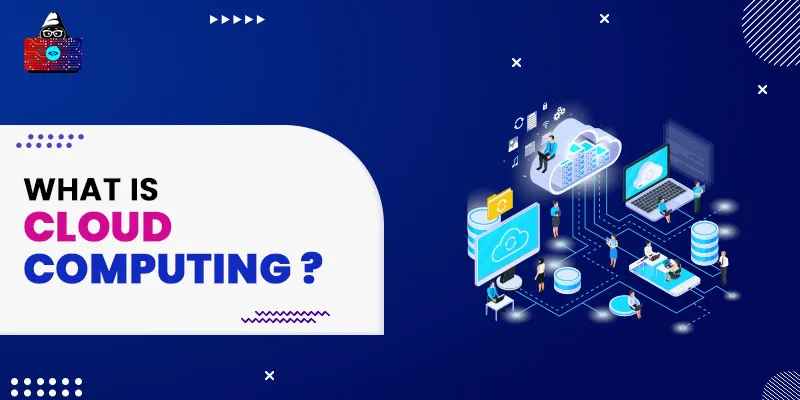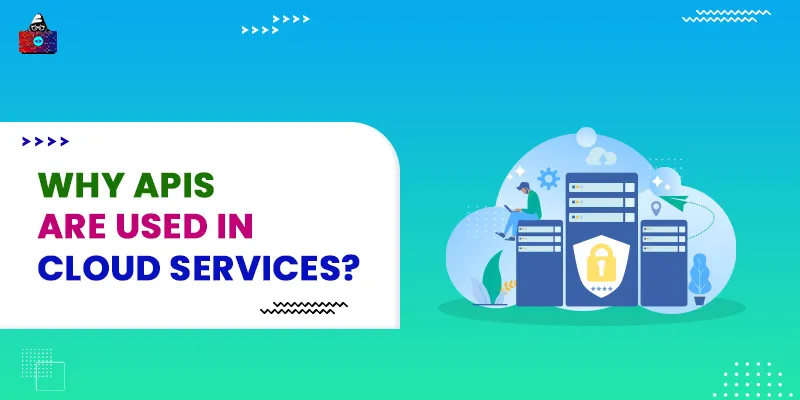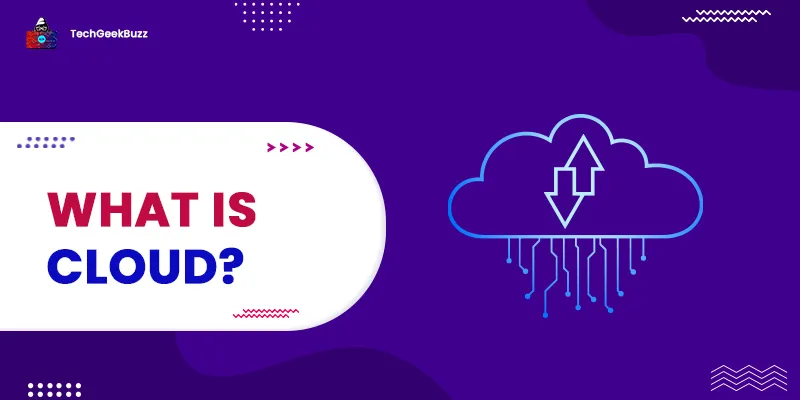Stored in the cloud, moving to the cloud, running in the cloud, accessed from the cloud: everything seems to happen in the cloud these days. But what exactly is the cloud?
The term ‘cloud’ in the tech domain refers to software and services that are stored on remote servers and can be accessed over the internet. In simple words, we can say that the cloud is a metaphor for the internet. Reliability and convenience are the two primary factors that have made many businesses and companies shift from traditional in-house IT infrastructures to the cloud.
Many of us might have used email services, like Gmail or Yahoo. All emails are stored on the cloud servers rather than on your desktop’s hard drive, allowing you to access those emails from anywhere and on any device using the internet. Therefore, cloud computing has made it easier for businesses to manage their activities without the need for maintaining physical servers.
This article shall discuss what cloud computing is, its characteristics, and the types of cloud computing services. Later, we will introduce you to cloud computing deployment models and a head-to-head comparison between cloud computing and traditional computing.
So, let us begin.
What is Cloud Computing?
Cloud computing refers to accessing IT resources, such as development tools, applications, servers, and databases via the internet. A remote data center hosts these IT resources, and a cloud services provider (CSP) manages them. Most organizations and businesses of any size utilize the cloud for numerous purposes, such as data backup, disaster recovery, big data analytics , and many more.
For instance, financial services providers use the cloud to promote and strengthen real-time fraud detection and prevention. Video game makers are hosting their games on cloud servers, thus making those games available to people worldwide.
Top 10 Characteristics of Cloud Computing
Here are some significant characteristics of cloud computing that make it one of the most in-demand technologies of today’s era:
1. Self-service Provisioning
Cloud computing enables end-users to provision, manage, and monitor computing resources as per their requirements. Therefore, there is no need for any human administrator to provision computer resources.
2. Elasticity
Elasticity is one of the most desirable characteristics of cloud computing. It allows businesses or organizations to scale up as the demand for computing resources increases and scale down as the demand decreases. The elasticity of cloud computing significantly reduces the need for local infrastructure and the costs associated with its setup and maintenance.
3. Broad Access
Using the internet connection, you can retrieve resources from or upload them to the cloud from anywhere and on any device that supports online access.
4. Pay Per Use
Pay per use is one of the most beneficial characteristics of cloud computing. It allows businesses and organizations to pay only for those services that they use; compute resources in the cloud are evaluated at a granular level.
5. Resilience
Resilience is when any service in the cloud recovers from the harm due to any disruption. Therefore, the cloud’s resilience is evaluated by how quickly its resources recover from any damage.
6. Migration Flexibility
Cloud computing offers migration flexibility, allowing companies to migrate their workloads to or from the cloud or to another cloud platform with ease.
7. Multi-tenancy
The multi-tenancy feature of cloud computing allows multiple users to share the same applications or the same physical infrastructure without compromising the security and privacy of their data.
8. Resource Pooling
The resource pooling feature of cloud computing allows cloud service providers to offer resources to multiple clients from the same resource pool. But the resource pool should be large and flexible enough to provide the required services to various clients.
9. Automation
Automation in cloud computing is the ability of the cloud to install, configure, and maintain services automatically. Therefore, automation in cloud computing reduces manual effort.
10. Security
Data stored on the cloud is secure as a copy of the data is created and stored in another server to avoid the risk of data loss. Therefore, if the data from one server gets lost, we can restore the copied version of data from another server.
Types of Cloud Computing Services
There are three different types of cloud computing services, as explained below:
1. Infrastructure-as-a-Service (IaaS)
Infrastructure-as-a-Service provides on-demand access to networking, storage, and compute resources on a pay-as-you-go-basis. Alternatively, we can say that IaaS offers the basic infrastructure for data storage drives, virtual servers, operating systems, and networks. It is a perfect cloud computing solution for small-sized and medium-sized companies and businesses.
IaaS is available as public, private, and hybrid infrastructure. In the IaaS service model, a cloud provider takes care of hard drives, data storage, networking, hardware, and servers, whereas users are responsible for managing applications, operating systems, and middleware.
2. Platform-as-a-Service (PaaS)
PaaS is a development and deployment environment in the cloud. It provides customers with a complete cloud platform for developing, running, and managing their own applications. A cloud provider offers a computing platform that includes a database, operating system, web server, networks, storage, and development tools.
This type of cloud computing enables faster development of applications. It is a perfect solution for businesses or companies where several developers work on a single project. AWS Elastic Beanstalk, Salesforce’s Lightning Platform, and Google App Engine are common examples of PaaS.
3. Software-as-a-Service (SaaS)
SaaS involves deploying and delivering software applications over the internet. These applications are often referred to as web services. Businesses and organizations use these software applications using pay-per-model or subscription-based pricing plans. The SaaS model lets users access software applications and databases. They can use these applications from anywhere and any device via the internet. Microsoft Office 365 is one of the best examples of SaaS.
Cloud Computing Deployment Model
A cloud deployment model is defined according to where the infrastructure for the deployment lies and who has access to that infrastructure. There are three cloud deployment models or cloud environments, as listed below:
1. Private Cloud
A private cloud is a dedicated cloud infrastructure owned by a single organization and is not shared with anyone outside the organization. All computing resources on the private cloud are exclusively available for the people within an organization. One of the most significant benefits of this cloud environment is that it offers the highest level of cloud security.
Moreover, a private cloud allows organizations to customize the storage, networking, and other computing resources as per their requirements. The only drawback of this cloud environment is that it is pretty expensive. VMware and OpenStack are examples of private cloud technologies.
2. Public Cloud
A public cloud is managed by a third-party provider, and various businesses or companies can access it using the pay-as-you-go pricing plan. Therefore, a public cloud is a shared infrastructure among multiple customers. This type of cloud environment is best suited for small and medium-scale businesses that have low budgets.
The public cloud is easy-to-manage, cost-effective, reliable, and scalable. But the only problem with it is it is not as safe as the private cloud. AWS from Amazon, Google Cloud from Google, and Microsoft Azure from Microsoft are typical and widely used public cloud platforms.
3. Hybrid Cloud
A hybrid cloud is a combination of both public and private clouds. The principal goal of a hybrid cloud is to provide a highly scalable environment that provides the benefits offered by the public cloud while retaining the security features of the private cloud. Alternatively, a hybrid cloud combines at least one private cloud and at least one public cloud by providing orchestration between them to create a single cloud environment.
Therefore, a public cloud performs critical activities, whereas a private cloud performs non-critical activities. AWS Outposts, Google Anthos, Azure Stack, and Azure Arc are some common examples of hybrid cloud.
Traditional Computing Vs Cloud Computing: Head to Head Comparison
The below explains significant differences between cloud and traditional computing.
| Traditional Computing | Cloud Computing |
| It utilizes physical data centers to store digital assets and run a complete networking system to carry out daily business operations. | It delivers computing resources like data storage, networking capabilities, applications, development tools, and servers over the internet. |
| Traditional computing takes place on physical hard drives. | Cloud computing takes place on third-party servers managed by third-party hosting organizations. |
| It enables users to access the data only on the system in which it is stored. | It allows users to access the data from anywhere and anytime via the internet. |
| As traditional computing requires maintaining in-house equipment and infrastructure, it is relatively more expensive than cloud computing. | There is no need to maintain physical servers, and you only pay for those services that you use. Therefore, cloud computing is cost-effective. |
| It offers less storage than cloud computing. | It offers more storage space and computing power required for applications to run effectively. |
Conclusion
In this tech-dominated era, cloud computing has become one of the most popular technologies. Cloud Computing offers multiple benefits for businesses and organizations of every size. Cloud computing is not just limited to storing data or accessing it on several devices. Instead, it offers a lot, like running software without installing it on a desktop, storing multimedia content, etc. If you choose to have a career in the cloud domain, it is important for you to develop a solid understanding of cloud computing. We hope that this article has helped you understand the broad concept of cloud computing.
People are also reading:


![What is Cloud Security? [Importance, Challenges, and Solutions]](/media/new_post_images/Cloud_Security.webp)


Leave a Comment on this Post